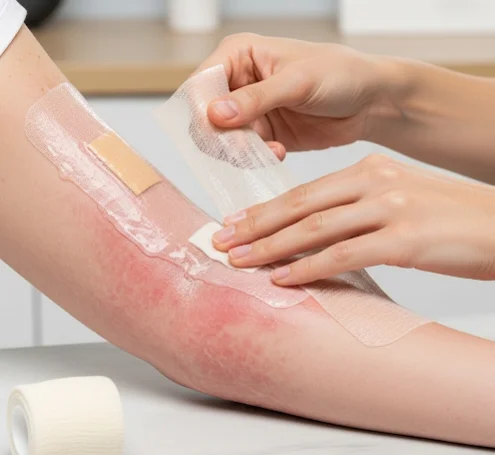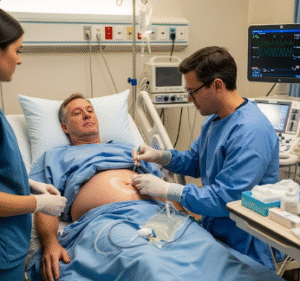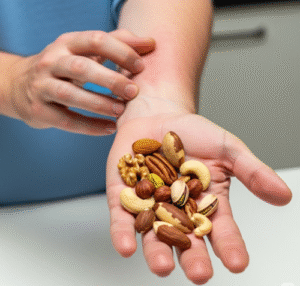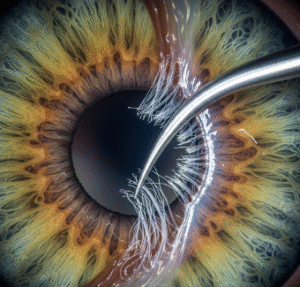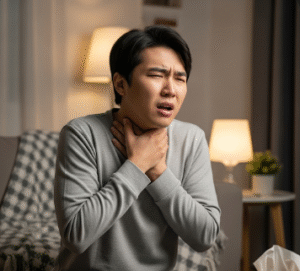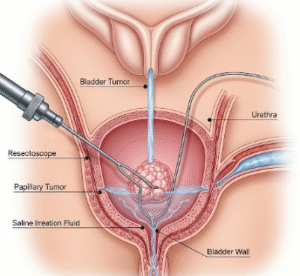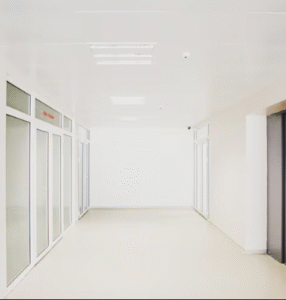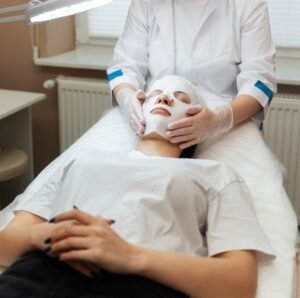What it is
Wet-wrap therapy for atopic dermatitis in Korea is a specialized treatment technique used to rapidly control severe eczema flares, intense itching, and widespread inflammation.
The method involves applying a layer of medicated or emollient cream, covering it with wet bandages or clothing, and then sealing with a dry outer layer. This creates a cooling, hydrating, and occlusive environment that:
- Enhances penetration of topical medications (such as corticosteroids or calcineurin inhibitors).
- Provides rapid relief from itching and inflammation.
- Restores skin barrier hydration.
→ In Korea, wet-wrap therapy is used in dermatology hospitals, pediatric allergy centers, and advanced eczema clinics, often as part of a comprehensive atopic dermatitis management program.
• Especially useful for children and patients with severe or treatment-resistant eczema.
• Provides short-term control during acute flare-ups, not intended as daily long-term therapy.
Why it’s done
Patients in Korea undergo wet-wrap therapy for:
→ Rapid eczema control → Reduces redness, scaling, and itching.
→ Severe flares → Especially when topical creams alone are not enough.
→ Sleep improvement → Soothes itching, helping children and adults sleep better.
→ Steroid-sparing effect → Enhances drug absorption, allowing use of lower doses.
→ Barrier repair → Rehydrates and restores skin barrier faster than creams alone.
Alternatives
Other treatments for atopic dermatitis include:
• Topical therapies → Corticosteroids, calcineurin inhibitors, PDE4 inhibitors.
• Moisturization → Regular emollient use as a long-term strategy.
• Phototherapy (NB-UVB) → For chronic, widespread eczema.
• Systemic medications → Cyclosporine, methotrexate, azathioprine, JAK inhibitors, biologics (dupilumab).
• Bleach baths → To reduce bacterial colonization in recurrent infections.
→ Wet-wrap therapy is chosen for acute severe flares needing quick relief.
Preparation
Before wet-wrap therapy in Korea, preparation includes:
- Dermatology evaluation → To confirm eczema severity and check for infection.
- Medication plan → Choosing whether to use steroid cream, non-steroidal anti-inflammatory cream, or just emollients.
- Skin cleansing → Gentle lukewarm bath or shower before treatment.
- Bandage/clothing preparation → Sterile bandages or special medical garments (cotton pajamas, wraps) are prepared.
→ Korean clinics often provide custom wet-wrap kits and training for at-home use.
How it’s done
Wet-wrap therapy in Korea follows a structured process:
- Topical application
- Steroid or calcineurin inhibitor applied to inflamed patches.
- Thick emollient layer applied over the entire affected area.
- Wet layer
- Sterile gauze, cotton bandages, or specially designed wet-wrap garments soaked in warm water and wrung out.
- Placed directly over the medicated skin.
- Dry layer
- A second layer of dry bandages or clothing is placed on top to retain moisture and protect bedding/clothes.
- Duration
- Wraps kept on for 2–6 hours or overnight, depending on doctor’s recommendation.
- Repetition
- Often used daily or several times per week during severe flare-ups.
→ Hospital-based therapy in Korea is supervised; at-home programs are taught to parents for children.
Recovery
Recovery with wet-wrap therapy is rapid and noticeable:
• Symptom relief → Itching and redness improve within 24–48 hours.
• Skin hydration → Significant improvement in barrier function after a few sessions.
• Short-term use → Typically continued for up to 1–2 weeks at a time.
• Maintenance care → After flares subside, patients transition to moisturizers and milder topical therapies.
→ In Korea, follow-up includes skin barrier repair routines with ceramide-based moisturizers.
Complication
While effective, risks include:
- Skin maceration → Overhydration can cause softening and breakdown.
- Infection risk → Occlusion may increase bacterial or fungal overgrowth if not monitored.
- Steroid over-absorption → If strong corticosteroids are used excessively.
- Discomfort → Some patients find the wraps too cooling or restrictive.
→ Korean dermatologists minimize risks by using low- to mid-potency steroids, short courses, and regular monitoring.
Treatment option in Korea
Korea offers advanced wet-wrap therapy programs for atopic dermatitis:
→ Pediatric allergy and dermatology hospitals → Specialized care for children with severe eczema.
→ Custom wrap garments → Clinics provide ready-made cotton wraps and medical pajamas for home use.
• Integration with other therapies → Often combined with probiotics, dietary counseling, and NB-UVB phototherapy.
• Barrier repair focus → Korean clinics emphasize intensive use of ceramide creams, hyaluronic acid serums, and mild cleansers.
• Medical tourism → Many patients travel to Korea for integrated eczema programs blending medical and skin-care expertise.
→ With its structured hospital training, modern wrap materials, and holistic skin-care philosophy, wet-wrap therapy in Korea is a highly effective short-term solution for severe atopic dermatitis.

